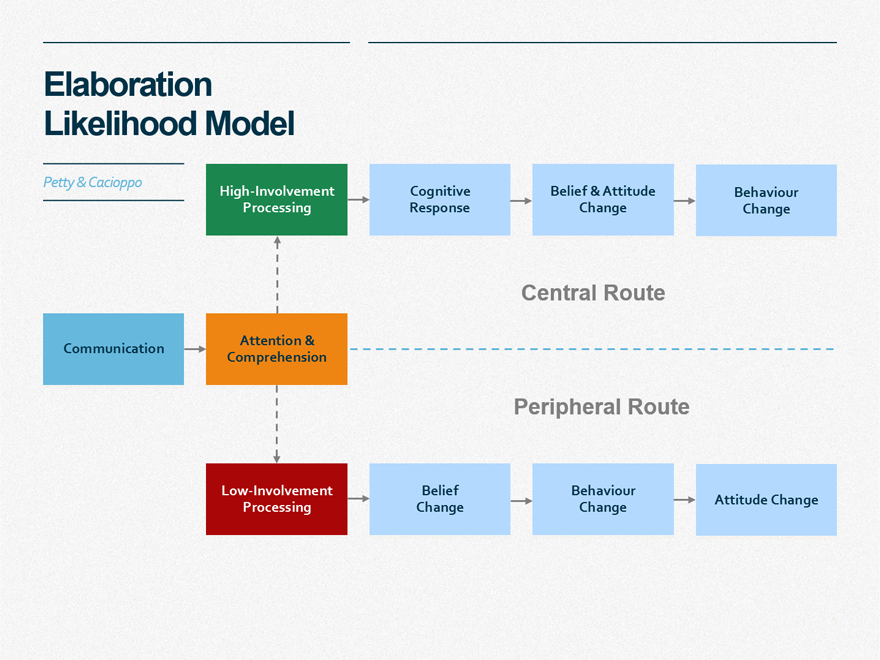Elaboration Likelihood Model
Originally published 21 Jul 2014
“The ability to kill or capture a man is a relatively simple task compared with changing his mind.” -Richard Cohen
Petty & Cacioppo describe two routes to changing someone’s mind – central versus peripheral – in their elaboration likelihood model

Which route to choose
In a persuasive situation, a person will choose a route based on motivation. If there is high involvement the central route is chosen. If there is low involvement the peripheral route is chosen. Next to – or complementary to – motivation, a person’s route (the level of elaboration) is also dependent on attitude (how you relate yourself to your surroundings – if it is your idea or not) and ability (available cognitive resources – amount of distractions). If the central route is chosen, more strong arguments will be more persuasive. If the peripheral route is chosen more weak arguments will be more persuasive.
Central Route
The central route triggers a cognitive response. A person is left to ponder about the proposition and will consequently form (new) beliefs & attitudes, and behaviour after that. This route is best chosen when a person can relate to the topic, has the ability to consider the arguments, the arguments are strong and there is no superficial information to distract the receiver. A boomerang effect can occur when the receiver disagrees with the arguments proposed.
Peripheral Route
The peripheral route targets a belief change. A person is reached via subliminal (not per se subconscious) messages that tend to enforce (or slightly alter) an existing belief. This route relies on simple cues and environmental factors. There are six types of cues: reciprocation, liking, social proofing, consistency, authority, and scarcity. This route is best chosen when a person neither has the motivation or ability to consider the arguments.
Examples
- Peripheral Route – A soda brand hands out samples in a shopping mall (reciprocation – you taste it, you buy it in the store once, you like it)
- Central Route – A professor tells his students about gravity and demonstrates it by thrown two objects of the same size, but different weights from a platform (strong argument)
- Peripheral Route – A celebrity recommends a certain fast-food chain (social proofing)
When to Use
The Elaboration Likelihood Model is to be used where you need to persuade your public. Most notably it is used in advertising. It can be used in everything from negotiations (with your children/parents) to presentations. Noted should be that different people at different times need different kinds of persuasion. Sometimes a person has the motivation and favorable attitude, at other times not. It is sometimes best to combine both kinds of cues for maximal effect.
More on the Elaboration Likelihood Model:
http://www.sciencedirect.com/science/article/pii/S0065260108602142 – Original article by Petty & Cacioppo
https://www.youtube.com/watch?v=TUNJ5ez10OU – Khan Academy Youtube explanation
http://343f11.pbworks.com/w/page/48434220/Elaboration%20Likelihood%20Model%20(ELM) – Further explanation and model
